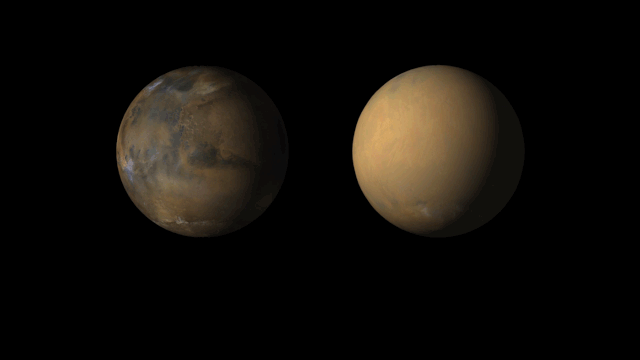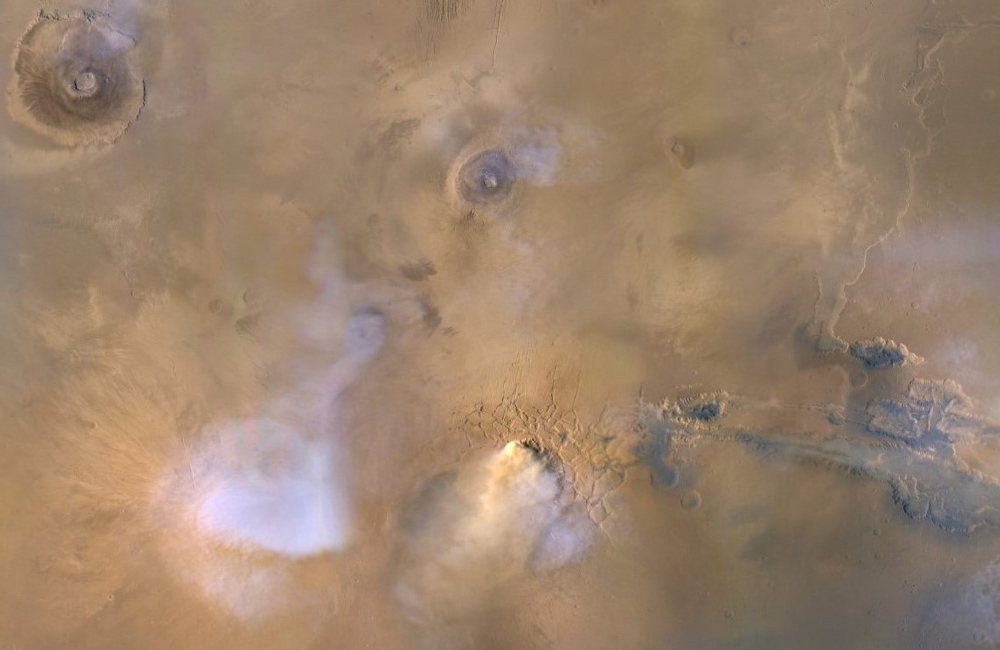Massive 'Dust Towers' on Mars Look Like Supersized Versions of Earth's Thunderstorms

Massive dust towers on Mars that formed during global storms may be "space elevators" that contributed to the loss of the planet's ancient water, according to NASA's description of new research.
Dust towers can loom dozens of miles above Mars' surface and are part of larger dust storms that sweep up the planet's iconic reddish dirt, blanketing the world. One giant storm last year brought NASA's Opportunity mission to an end and masked Mars' features in a dull coating of dust, as seen in an incredible moving image from NASA's Mars Reconnaissance Orbiter. The scientists behind the new research said they wanted to better understand how storms like these work.
During a global storm, dust towers "are renewed continuously for weeks,'' the lead author for both papers, Nicholas Heavens of Hampton University in Hampton, Virginia, said in a recent NASA statement about the dust towers. The space agency said that in some cases, it observed multiple towers for as long as 3.5 weeks. These structures stretch upward, much like thunderstorm clouds do on Earth, and the researchers said the dust towers may have played a part in the evaporation of Mars' ancient water into space.
Related: Watch Clouds on Mars Drift by in Supercomputer Simulations
The sight of an Earthly thunderstorm cloud is unmistakable: The tall formation is ominous, and people exercise caution after spotting one, as the cloud could bring dramatic atmospheric activity like a lightning strike. Thunderstorm clouds grow tall because of the sun; as the heat from the star warms the moisture in Earth's atmosphere, water particles ascend higher into the sky.
That heat also powers dust towers on Mars. The dust clouds, described in NASA's statement as "space elevators," lift particles of water and dirt that have hitched a ride on the rising dust streamers that create the cloud. The updraft carries water vapor and one of its gaseous building blocks, hydrogen, up to the planet's upper atmosphere; here, in Mars' ancient past, these particles may have then evaporated and disappeared from the Red Planet in large quantities.
To understand how Earthly thunderstorm clouds affect our daily lives, meteorologists study the larger phenomenon, known as deep convection, that produces them. Mars has a deep convection system as well, and the scientists behind the new research studied that system for answers about Martian dust storms.
Get the Space.com Newsletter
Breaking space news, the latest updates on rocket launches, skywatching events and more!

The first of the two recent papers published by Heavens' team laid out a framework for how to study this Martian convection system. Researchers called the Red Planet's atmospheric conveyor belt "dusty deep convection."
In their more recent paper, the researchers studied the last two dust events that engulfed Mars, which occurred in 2007 and 2018, and how water molecules were moving around the planet at the time.
There are still some mysteries about dust towers and the role they play in massive dust storms. One idea is that the dust towers form randomly from lifted dust; another is that they come together as hurricane-like storms that then envelop the planet in dust.
The November 2019 study was published in the Journal of Geophysical Research, and the October 2019 study was published in the Journal of the Atmospheric Sciences.
- Water on Mars: Exploration & Evidence
- NASA Spacecraft Spots 'Star Trek' Logo on Mars
- Bam! Fresh Crater Spied on Mars — and It Looks Spectacular
Follow Doris Elin Urrutia on Twitter @salazar_elin. Follow us on Twitter @Spacedotcom and on Facebook.

Join our Space Forums to keep talking space on the latest missions, night sky and more! And if you have a news tip, correction or comment, let us know at: community@space.com.

Doris is a science journalist and Space.com contributor. She received a B.A. in Sociology and Communications at Fordham University in New York City. Her first work was published in collaboration with London Mining Network, where her love of science writing was born. Her passion for astronomy started as a kid when she helped her sister build a model solar system in the Bronx. She got her first shot at astronomy writing as a Space.com editorial intern and continues to write about all things cosmic for the website. Doris has also written about microscopic plant life for Scientific American’s website and about whale calls for their print magazine. She has also written about ancient humans for Inverse, with stories ranging from how to recreate Pompeii’s cuisine to how to map the Polynesian expansion through genomics. She currently shares her home with two rabbits. Follow her on twitter at @salazar_elin.
-
rod The report showed an image of Mars before and during the big dust storm last year. "The Mars Color Imager (MARCI) camera onboard NASA's Mars Reconnaissance Orbiter (MRO) shows the typical state of Mars, seen here in May 2018, and what the planet looked like during a planet-encircling dust storm in July 2018."Reply
Many amateur telescope users viewed Mars in July 2018 during the Mars opposition and dust storm. I viewed too during Mars opposition and the yellowish or almost pumpkin color was widely reported by telescope observers like myself. I am looking forward to Mars opposition of 2020 in October and no dust storm (hopefully). Telescope observations show NASA does not report *fake news* as some claim today :) Seeing the images in this report brought back memories and written in my stargazing log. Of course, MRO shows a better view though but my telescopes were still pretty good :) -
Gordon Jenkins Wow! I think it's called the Sun. Without a magnetic field to protect Mars (or Earth during Geomagnetic pole reversal like right now), a major CME, Super Flare or Micro Nova would be all that is required and that's all she wrote. Kind of like How Earth lost a huge amount of Oxygen and how mega Fauna disappeared from North America. How do you miss or obfuscate from something like that?Reply -
rod Yes, the Sun - the Faint Young Sun. Earth during deep Precambrian time was a SnowBall Earth :) Just think about Mars and the Faint Young Sun, billions of years ago, orbiting even farther out from the Sun. The primordial and Precambrian Sun plot or position on the H-R star diagram is nothing like today's friendly, warm Sun :)Reply -
Wally Mayo We see these upshoots today. But, how about billions of years ago? Could these be a result of the decimation of Mars atmosphere much earlier?Reply
Virginia Tech geophysicists analyzed the jarosite mineral detected by the Mars Exploration Rover Opportunity. Rather than proving that Mars once provided a warm, wet environment conducive for the origin and proliferation of life, the discovery instead demonstrates that liquid water only briefly existed on Mars, in limited amounts, and under chemical conditions toxic for life’s origin and survival. Moreover, they demonstrated that the survival to the present time of jarosite on Mars, in combination with residual basalt, proves that Mars has remained extremely arid since the time of the formation of Martian jarosite. The team’s analysis adds to the weight of evidence that Mars is far more inhospitable for life than previously thought and Earth is much more exquisitely fine-tuned for life than previously thought.
https://www.nature.com/cgi-taf/DynaPage.taf?file=/nature/journal/v431/n7010/abs/nature02971_fs.html
Thinking of magnetic fields, Mars’ dynamo shut down 4.0–4.1 billion years ago and has never restarted since then. Furthermore, the lower a planet’s atmospheric pressure, the more rapid its rate of water loss and the greater its radiation dose at the planet’s surface. While the shutdown of Mars’ dynamo might not have been immediately detrimental to possible life, the long-term effects of the dynamo shutdown would have been permanently catastrophic and would guarantee the loss of vitually all of Mars’s surface water, early on.
Good discovery and innovative thinking. I’m just not convinced the dust towers are the main mode of Mars water exit.









